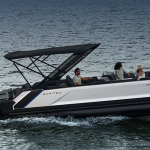Eurobike 2015, which takes place in Friedrichshafen, Germany August 26 to 28, will feature a host of technical improvements to make 2016 one of the most exciting model years in a long time for the racing and mountain bike segments.
Among the innovations and new terminology expected to emerge at the show are 27+, size split, boost standard and flat mount.
27+ tires
The fact that mountain bike manufacturers have enjoyed experimenting with new tire sizes for the last few years is fairly well known in the bike scene. This experimentation has led to several new trends, such as 29ers, 650b and fatbikes. Another new tire size is arriving for 2016. The 27+, which has trendsetting potential and combines the best of several worlds, is based on a wide rim in 650b format, also called 27.5, that has been equipped with a 2.8 to 3-inch tire. The alteration places it between a traditional all-mountain tire and a fatbike. The result is a tire width that offers especially high traction but does not tip the scales in the way that heavy fatbike tires do.
The mountain bike industry sees a lot of potential not only in bikes suited to a wide variety of terrains and uses, but especially in the rapidly growing e-mountain bikes category. It is a category where the somewhat wider tires can make full use of their traction potential, yet in which their slightly increased weight plays little role.
Size split
Wheel sizes are also at the center of the second big mountain bike trend for 2016, the size split. This term refers to bike manufacturers’ new strategy of equipping more and more models with several possible wheel formats, depending on frame size. Next year, a given retailer may sell a size S mountain bike model equipped with 650b wheels alongside the same model in size M that offers a choice between 605b and 29ers, next to a size L that is only available with 29ers.
Boost standard
The new Boost standard is also about width. For 2016, mountain bike manufacturers have decided that wider is also better where hubs are concerned. Especially in endurance races or at bike parks, wheels with traditional hub widths can be pushed to the limits of their stability. Hubs that have been widened by six millimeters in the case of back wheels and ten in the case of front wheels are intended to provide broader support to spokes, thereby ensuring more stability.
Comfort is in demand in the racing bike segment. A clear sign of this trend is the fact that, for the 2016 model year, most racing bikes can be equipped with broader tires. The majority of models will roll off the assembly lines with (already broad) 25mm tires, but in most cases the bike frame and fork leave enough room for even more comfortable 28mm tires. Just a few years ago, racing bike purists turned up their noses at such formats, which seemed close to those of trekking bikes (which start at 32mm), but now more and more riders, especially larger and heavier ones, value wider tires’ added comfort and better grip.
Disc brakes for road racing
The fact that traditionalists are no longer the only ones with a say in the racing bike market is also demonstrated by the success of disk brakes in the segment. Experts have little doubt that this brake technology will reign victorious in the racing bike scene in the coming model year. While rim brakes used until now offer very respectable response times, the advantages of disk brakes become convincing in wet conditions and when the brake lever is only gripped from above, or with one or two fingers. In the future, many racing bike enthusiasts will come to appreciate disk brakes’ increased safety and more relaxed hands, as they require less force to operate. Also in 2016, the bike industry is introducing Direct Mount, a new and elegant mounting standard for brake calipers on racing bikes that will reduce the weight difference between rim and disk brakes to just a few hundred grams.
A comprehensive overview of the future state of technology in the bicycle market will be offered by Eurobike in Friedrichshafen, which becomes the hub of the bicycle world for a few days at the end of August. Whereas the first three days of the show are traditionally reserved for the specialty trade and media, Eurobike will open its doors to all bike enthusiasts on the last day of the show, Saturday August 29.
The Eurobike international bike trade show will be open to industry visitors only from Wednesday, August 26 to Friday, August 28, 8:30 a.m. to 6:30 p.m., opening to the general public from 9:00 a.m. to 6:00 p.m. on public day, Saturday, August 29. Eurobike Demo Day will take place on Tuesday, August 25, from 10:00 a.m. to 5:00 p.m. and is only open to trade visitors and accredited journalists.















